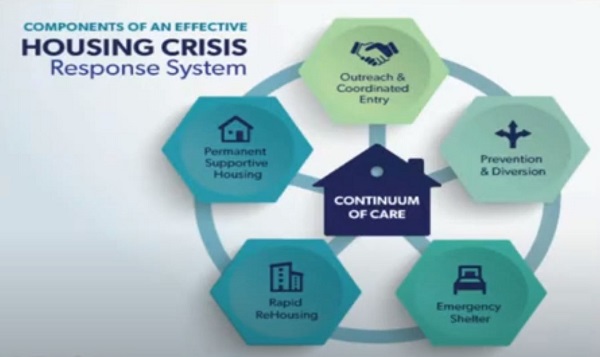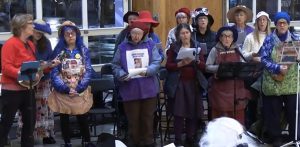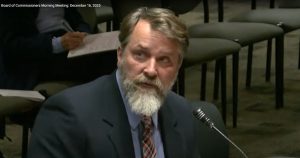County faces $4 million in cuts for homeless: ‘We’re not taking all the dollars on the table’
8 min read
Lane County hopes to preserve its homeless response system, as it prepares to make $4 million in cuts. At the Poverty and Homelessness board Feb. 15:
Kate Budd (HSD manager): The Human Services Division has been working on their Fiscal Year 2024-2025 budget. And we are seeing that we are short about $4 million to support current contracts that we have for programming that focus on homelessness and community action.
[00:00:38] I’m sharing this information with you today to help us share with the commissioners what you think ought to be done as far as reducing the overall number of programs.
[00:00:50] One priority for Lane County is to make sure that when we are done with program reductions, that we still have the needed components of a homeless crisis response system and continue the inflow and outflow of folks so that they are transitioning into permanent housing when it is possible.
[00:01:12] So just as a reminder, this is what a holistic homeless crisis response system looks like: Making sure that we have outreach, permanent supported housing, rapid rehousing, emergency shelter, and then prevention and diversion. And so we would want to make sure we have at least one program in each of those areas to be a complete and holistic continuum of care.
[00:01:38] The ARPA dollars are nearly all but spent. And so in 2024 there were almost $6 million that was utilized to continue our COVID increase in programs. And unfortunately, not only does COVID (funding) need to be spent by December of 2024, but our overall amount of COVID dollars is waning.
[00:02:09] And so that’s really where the most significant reduction in funding is coming from.
[00:02:16] We’re facing this $4 million reduction, not only because of ARPA, but also because we’re losing other COVID-related dollars. And those have come and they have gone. And so that’s a reduction.
[00:02:33] We also, in this current fiscal year, saw dollars that Lane County expected to receive and then allocate out for emergency shelter actually get contracted directly to emergency shelters. And so it just means that we’ve had to narrow down our budget and then have conversations with the shelters about, ‘How much are you getting from the state? Okay, we’ll give you this much money.’
[00:03:02] And in this current fiscal year, the state chose not to give admin with the emergency shelter funds, for example. And so Lane County is having to provide admin dollars, but then we don’t need to provide all the operation dollars we’ve anticipated. And so unfortunately, it just means less money for Lane County to allocate out. And greater complication.
[00:03:25] So the opportunity today is to share thoughts and ideas regarding how you would advise our county commissioners to approach reducing program contracts. Again, what is that big picture approach?
[00:03:40] One could be that the Human Services Division conducts a full Request For Proposal (RFP) for all programs that focus on community action and homelessness. And what that would do is it would provide an opportunity for agencies to put their best foot forward, to be able to ask for what they need, and then the county would facilitate its usual process where the applications are scored, then the dollars are allocated based on the highest application scores, you know, based on what dollars are available.
[00:04:21] And then, of course, there would be some some programs that would not be funded.
[00:04:25] Another potential policy option B is to just roll back to pre-COVID programs. And so a program that was created in response to COVID would be one that would no longer move forward in the next fiscal year.
[00:04:44] (Option) C is funds based on which program meet or come close to outcomes or outputs. And so we’d be looking at where each program is based on their contracted requirements, and those that are exceeding and meeting would be prioritized for funding. And then those that are very much not meeting their outcomes would not be funded.
[00:05:09] And then (option) D could be recognizing that we have ‘All In’ programs and reducing based on where All In is helping to fill in programmatic gaps. So we saw, for example, there’s significant funding for rehousing with All In. And so it would mean we would reduce or potentially eliminate the rehousing programs that are not funded through All In.
[00:05:40] It could also be the same thing with emergency shelter, that we would look at reducing the number of emergency shelters because we do have other emergency shelters available with All In.
[00:05:53] And so what I’ve been asked to do is to bring high-level policy options to the county commissioners. (I) certainly recognize that these are not ideal and that there could very much be a hybrid path forward: Choose B and C and then pull them together. But these were a few of the policy options that have bubbled up in the last few weeks.
[00:06:22] And so we’re ripe for an opportunity to make some notable changes, to make sure that moving forward, the programs can achieve what is being asked of them.
[00:06:35] I think All In was a good example where for the first time in my experience here in Lane County, it wasn’t about the dollars, like, there were plenty of dollars, which was exciting, because that’s not the case with our other funding sources. They’re very, very scarce.
[00:06:54] Kris McAlister (Carry It Forward, outgoing PHB vice chair): Kate, I have a couple of questions and I appreciate your leadership on this and your helping us navigate this. Part of my concern is that we’re not taking all the dollars on the table.
[00:07:09] There are ways to defer some of these costs, such as if we’d utilized emergency management as part of our All In. We got some feedback from the federal trainer that came in to talk to us about fiscals, about how what we do at the county is not necessarily at best practice.
[00:07:25] And so I’d like to be able to figure out: Is there a mechanism to recommend to the Board of County Commissioners to look at how it’s doing certain policies regarding RFPs, how it’s doing additional and sometimes extracurricular admin requirements that are not necessarily required by federal or state law, but are kind of a residual from old school work and social services, and to utilize and spread the needs across multiple programs.
[00:07:55] We’ve been asking for over six years for more engagement from HHS (Lane County Health and Human Services) in regards to emergency management and public health. That’s why one of the referrals was that we add a seat from public health to the PHB (Poverty and Homelessness Board) so that way we can utilize CCO (Coordinated Care Organization) dollars and emergency dollars in a more effective manner, so that way it’s not all on the burden of what is predominantly a housing-focused emergency relief department.
[00:08:22] John Q: The PHB also heard from the Lived Experience Advisory Group on Unhoused Experience (LEAGUE).
[00:08:29] Richard Self (LEAGUE chair): It’s come to my attention, especially in the event of the ice storm and the lack of a hospital here, that we need to designate a actual emergency destination so people know where to go in an emergency.
[00:08:48] We live in a volatile world now, so there could be anything from a disaster like we just experienced to an earthquake to a nuclear attack.
[00:08:59] We need to have a designated emergency shelter provided and we need it soon because we have not have any place that’s designated to do that.
[00:09:15] Pat Farr (Lane County commissioner): Thank you, Mr. Self. I think I can speak for everyone in the room that we did recognize the nature of the emergency and that there really were very few places for people to be evacuated or removed to, which put a great deal, a tremendous overburden on the few places that were available, not just in the metropolitan area, but outside the metropolitan area also. We had a tremendous burden on places where there was some form of shelter, to the point where it was very difficult for people to either access or to actually maintain a stable shelter. Thank you, Mr. Self, for that… Vice Chair McAlister.
[00:09:46] Kris McAlister (Carry It Forward): As the outgoing vice chair of homelessness, we must really be data-driven. And we need to make sure that we are representing what our HMIS (Homeless Management Information System) and other items do. I would like to ask that anybody taking this position follow with what we can prove, not what is believed in our communities. We have HMIS saying that 80% to 85% of our population come from this area. We need our truth to be spoken.
[00:10:11] I’ve been on the Poverty and Homelessness Board for seven years now. I was the lived experience seat. In order to avoid tokenism, and in order to not just run things through, we created LEAGUE to make sure that all voices, all experiences are being represented in the body of work.
[00:10:31] My biggest concerns as someone with lived experience who has worked in a county process, in a city process, is that we need to be faithful stewards to the lived experience if we’re going to expand it.
[00:10:44] It’s very daunting when the public blames the people who have the lived experience who were not listened to and things that were rolled out or passed out. So I ask with all sincerity please make sure that if you bring five lived experience seats on (to the PHB), that they do not go through the same lumps and issues that we as the founding group of LEAGUE have.
[00:11:08] Our work is constantly questioned when we are working with county staff to develop our goals and our dreams.
[00:11:13] In the past, we had allocated an open seat on each committee so that way we can invite members of the LEAGUE or other community members. And at one point we even had two seats just to make sure that it wasn’t, again, saddled on the shoulders of one lived experience and then if, say, a city backs out or changes their mind on something like harm reduction or something like that, one person isn’t blamed or held accountable by the greater community, like, ‘You had your chance to change it, you had your chance to participate and you didn’t.’
[00:11:44] So I’d like to, just as we look at safeguards: We carve space for it, we hold space for it, and then we also engage and have a mentorship to make sure that they are being supported in the work, whether you’re a veteran suffering from PTSD or a mother with children, your voice has value. And we need to make sure that it actually is part of the process. It’s very daunting.
[00:12:04] And we’ve had several people leave LEAGUE because the body of work was too intense. The stuff is too intense. So framing and supporting, not just holding the space open: How do we actually keep the lived experience flowing through those committees?
[00:12:20] And that’s not to diminish any of the professional experience or community experience that our electeds and our providers on these same committees bring. It’s just there’s a different nuance when you’re dealing with poverty and homelessness. And some of the people at the table haven’t experienced what you’ve had to experience.
[00:12:39] John Q: The Poverty and Homelessness Board is asked to help craft a high-level strategy as Lane County faces the loss of $4 million in one-time federal funding. Kris McAlister points out that the county is leaving a lot of money on the table because it has not adopted best practice. He recommends more engagement on the board from public health and emergency management.





